他们为化学创造了新的空间
——2025年诺贝尔化学奖通俗解读
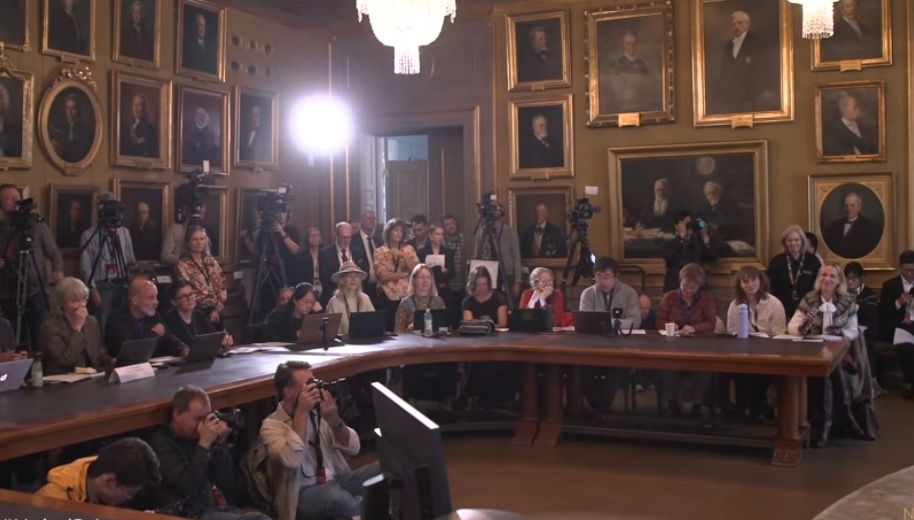
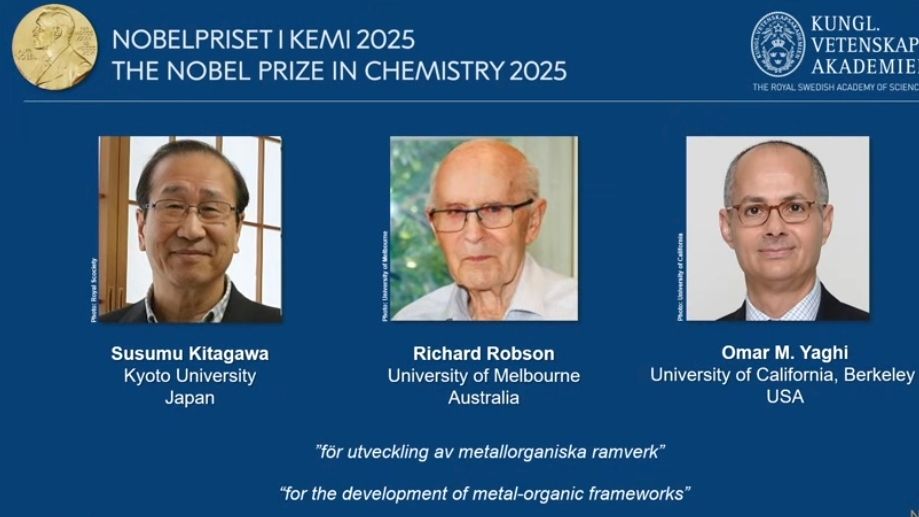
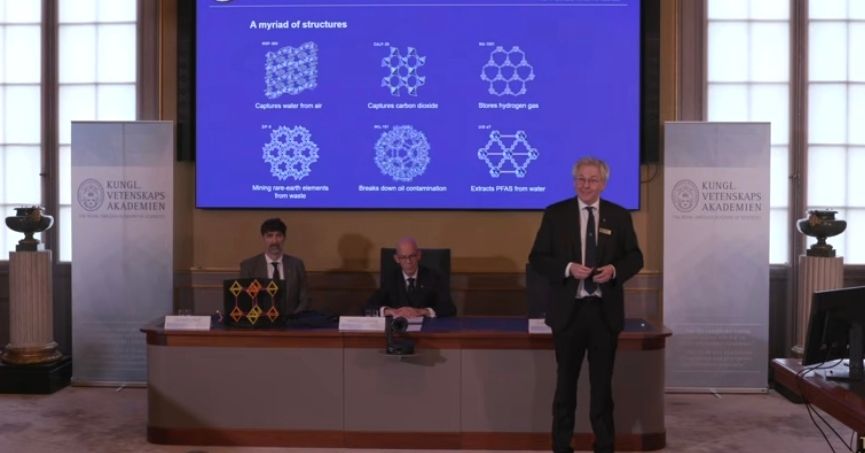
获奖者:
三位科学家因**开创了全新的分子架构——金属有机框架(Metal–Organic Frameworks,MOFs)**而共同获得2025年诺贝尔化学奖。他们所构建的这些结构中存在巨大的空腔,分子可以自由进出。研究人员已利用这些结构从沙漠空气中提取水分、从污水中去除污染物、捕获二氧化碳、储存氢气等。
一、分子世界的“宽敞公寓”
如果用房地产经纪人的口吻来描述MOF,可以这样说:“一间为水分子量身定制、宽敞而优雅的单间公寓。”世界各地实验室近几十年来已开发出无数这样的“分子建筑”。其中一些用于捕获二氧化碳、从水中分离PFAS(全氟化物污染物)、递送药物,或吸附极其有毒的气体。有的甚至能捕获水果释放的乙烯气体,使其延缓成熟;还有的可包裹能分解抗生素残留的酶。
简而言之,金属有机框架极其有用。北川进、罗布森和亚基获奖,是因为他们首次创造并证明了这种结构的可行性。正因他们的努力,化学家如今已设计出上万种不同的MOF,开启了化学的“分子奇迹时代”。
正如许多科学突破一样,这个故事起源于一次“跳出框架的思考”——最初的灵感,竟来自一堂学生的经典化学课。
二、木制分子模型带来的灵感
1974年,澳大利亚墨尔本大学的理查德·罗布森正在准备教学用的分子模型——把木球当作原子、木棍当作化学键。要让模型准确,他必须在木球上钻孔,并精确标出不同原子的连接方向。
当模型制作完毕后,他突有所悟:孔洞的位置本身蕴含着巨大的信息量。分子的几何结构之所以自动呈现出正确形态,正是因为“原子的连接方式已内嵌在结构之中”。
于是他产生了一个大胆想法:
“如果我利用原子本身的配位特性,不是让它们单独成键,而是让它们带动整个分子去连接,会不会产生全新的分子结构?”
三、罗布森的分子建筑实验
这个念头在他心中萦绕多年。直到十多年后,他终于着手验证。他以钻石为灵感——在钻石中,每个碳原子与四个其他碳原子键合,形成金字塔状结构。罗布森选择用带正电的铜离子取代碳原子,再配上一个“四臂”的有机分子:4′,4″,4‴,4⁗-四氰基四苯基甲烷(tetracyanotetraphenylmethane)。每个分子的四个臂末端带有吸引铜离子的腈基(–CN)。
多数化学家当时会认为这种组合只会生成混乱的“离子鸟巢”。然而,实验结果出乎意料:铜离子与有机分子凭自身的化学亲和力自动排列成有序的晶体结构。与致密的钻石不同,这种晶体内部布满了巨大的空腔。
1989年,罗布森在《美国化学会志》发表成果,并大胆预测这种方法将开辟“构筑新型功能材料的道路”。事实证明,他预见了未来。
四、从“无用之用”到革命性突破
此后,罗布森持续合成具有空腔的分子晶体,用于离子交换实验,证明分子可在其中进出流动。他首次提出可通过**理性设计(rational design)**建造具有特定化学功能的多孔晶体。
然而,这些早期结构仍然脆弱、不稳定。多数同行认为“没有实用价值”,但他唤醒了一批年轻科学家的探索精神——其中包括日本的北川进与美国的奥马尔·亚基。
五、北川进:从“无用”中发现“有用”
北川进一直奉行一个研究信念:“发现无用之用。”早年他受到日本诺贝尔物理学奖得主汤川秀树的影响,后者引用中国古代哲学家庄子的话:“无用之用,方为大用。”
1992年,北川构建出第一个二维多孔分子材料,内部空隙可容纳丙酮分子。尽管当时用途不大,但这是首次在分子层面实现有序多孔结构。他同样以金属离子为“角点”,用较大的有机分子将其连接。
但他的研究一度被评审拒绝——理由是“不稳定、无实用性”。
直到1997年,他的团队利用钴、镍或锌离子与4,4′-联吡啶(bipyridine),成功合成出三维金属有机框架。这种材料干燥后仍保持稳定,可吸附并释放甲烷、氮气或氧气,而结构不变。
六、MOF的独特之处
1998年,北川在《日本化学会会报》发表文章,系统阐述了MOF的优势:
这篇论文让MOF从“无用”走向“独特”,他由此奠定了理论基础。
七、亚基:从安曼小屋到伯克利实验室
奥马尔·亚基出生于约旦安曼的贫困家庭,自幼生活艰辛。10岁那年,他闯入学校图书馆,翻开一本充满奇异图形的化学书,从此迷上了分子结构。
15岁时,他被父亲送往美国求学。1992年在亚利桑那州立大学建立自己的实验室后,他试图用理性设计方式组装分子,如同“化学乐高”。1995年,他合成出由铜或钴连接的二维网络晶体,其中一种能稳定到350°C。他在《Nature》上发表论文,并首次提出“金属有机框架(Metal–Organic Framework)”这一术语。
八、MOF-5:像足球场一样大的表面积
1999年,亚基推出经典作品——MOF-5。这种材料结构稳定、空腔巨大,即使加热到300°C也不坍塌。仅几克样品,其内部表面积可达一个足球场之大。这意味着,它能吸附的气体量远超传统沸石。
几年后,北川等人也实现了“柔性MOF”,能在吸附水或甲烷时伸缩自如,犹如能呼吸的“分子肺”。
九、让沙漠空气变成饮用水
2002至2003年,亚基在《Science》和《Nature》连续发表论文,展示可系统调控MOF孔径与功能的方法。他开发出16种MOF-5衍生物,其中部分能高密度储存甲烷,用于清洁能源汽车。
此后,MOF技术席卷全球。研究者利用人工智能与模块化设计,创造出成千上万种新型结构。例如,亚基团队在亚利桑那沙漠通过MOF材料从空气中提取饮用水:夜晚吸附水汽,白天经阳光加热释放水分。
十、应用实例:从净水到储能
现代研究者已制备出各种功能性MOF(图示7):
十一、结语:21世纪的材料
一些科学家认为,MOF将成为21世纪的代表性材料。无论最终命运如何,北川进、理查德·罗布森与奥马尔·亚基的贡献,都为化学家提供了全新工具,帮助人类应对能源、环境与可持续发展的挑战。
正如阿尔弗雷德·诺贝尔遗嘱所言:
“他们的研究,已为人类带来最大的福祉。”
资料来源:瑞典皇家科学院(The Royal Swedish Academy of Sciences)
作者:Ann Fernholm
科学编辑:Peter Brzezinski,Heiner Linke,Olof Ramström,Xiaodong Zou(邹晓冬院士)
译者(本稿):ChatGPT中文全译版(依据原始英文全文)
They have created new rooms for chemistry
Susumu Kitagawa, Richard Robsonand Omar M.Yaghiare awarded the Nobel Prize in Chemistry2025for the development of a new type of molecular architecture.The constructions they created–metal-organic frameworks–contain large cavities in which molecules can flow in and out.Researchers have used them to harvest water from desert air,extract pollutants from water,capture carbon dioxide and store hydrogen.
An attractive and very spacious studio apartment,specifically designed for your life as a water molecule–this is how an estate agent might describe one of all the metal-organic frameworks that laboratories around the world have developed in recent decades.Other constructions of this type are tailormade for capturing carbon dioxide,separating PFAS from water,delivering pharmaceuticals in the body or managing extremely toxic gases.Some can trap the ethylene gas from fruit–so they ripen more slowly–or encapsulate enzymes that break down traces of antibiotics in the environment.

Simply stated,metal-organic frameworks are exceptionally useful.Susumu Kitagawa,Richard Robson and Omar Yaghi are awarded the Nobel Prize in Chemistry2025because they created the first metal-organic frameworks(MOF)and demonstrated their potential.Thanks to the laureates’work,chemists have been able to design tens of thousands of different MOFs,facilitating new chemical wonders.
As so often in the sciences,the story of the Nobel Prize in Chemistry2025begins with someone who thought outside the box.This time,inspiration came during preparations for a classic chemistry lesson,in which the students were to build molecules from rods and balls.
A simple wooden model of a molecule generates an idea
It was1974.Richard Robson,who was teaching at the University of Melbourne,Australia,had been tasked with turning wooden balls into models of atoms,so students could create molecular structures.For this to work,he needed the university’s workshop to drill holes in them,so that wooden rods–the chemical bonds–could be attached to the atoms.However,the holes could not be randomly placed.Each atom–such as carbon,nitrogen or chlorine–forms chemical bonds in a specific way.Robson needed to mark out where the holes should be drilled.
When the workshop returned the wooden balls,he tested building some molecules.This was when he had a moment of insight:there was a vast amount of information baked into the holes’positioning.The model molecules automatically had the correct form and structure,because of where the holes were situated.This insight led to his next idea:what would happen if he utilised the atoms’inherent properties to link together different types of molecules,rather than individual atoms?Could he design new types of molecular constructions?
Robson builds innovative chemical creations
Every year,when Robson brought out the wooden models to teach new students,the same idea occurred to him.However,more than a decade passed before he decided to test it out.He started with a very simple model,inspired by the structure of a diamond,in which each carbon atom bonds to four others,forming a tiny pyramid(figure2).Robson’s aim was to build a similar structure,but his would be based on positively charged copper ions,Cu.Like carbon,they prefer to have four other atoms around them.+
He combined the copper ions with a molecule that has four arms: 4′,4″,4”’,4””-tetracyanotetraphenylmethane.There’s no need to remember its complicated name,but it is important that the molecule at the end of each arm had a chemical group, nitrile,that was attracted to the positively charged copper ions(figure2).
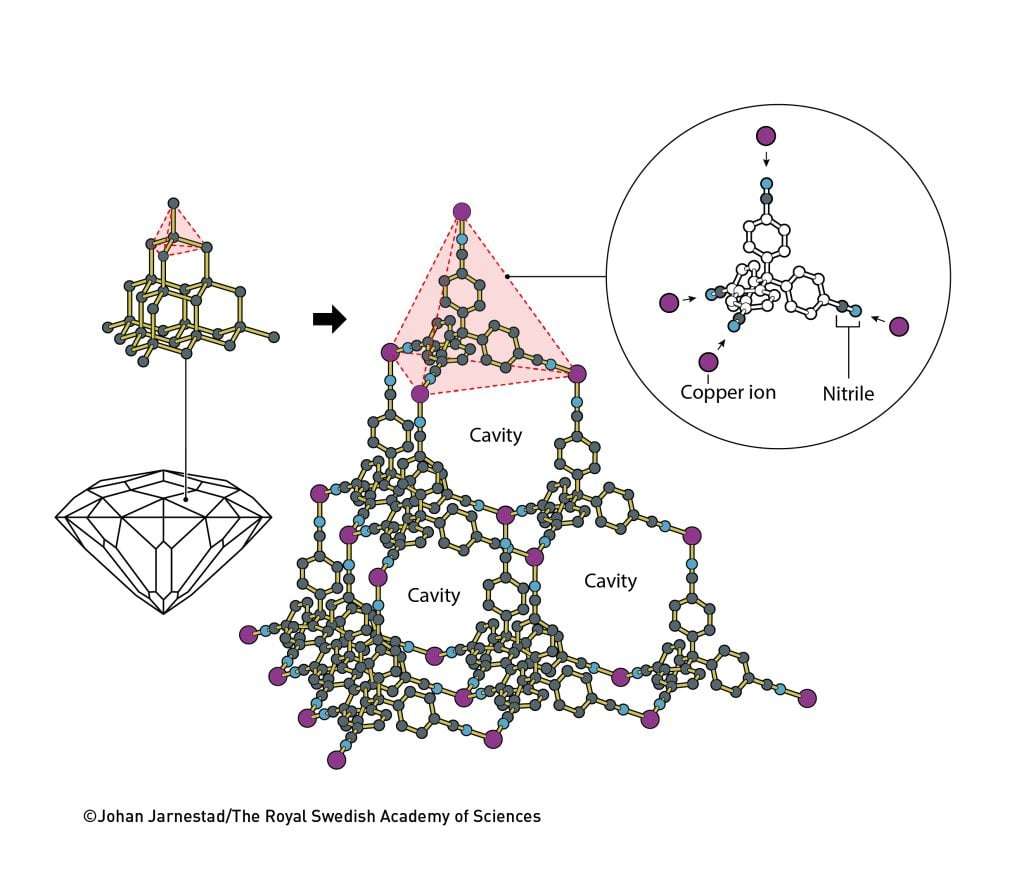
At that time,most chemists would have assumed that combining copper ions with the four-armed molecules would result in a bird’s nest of ions and molecules.But things went Robson’s way.As he had predicted,the ions and molecules inherent attraction to each other mattered,so they organised themselves into a large molecular construction.Just like carbon atoms in a diamond,they formed a regular crystalline structure.However,unlike diamond–which is a compact material–this crystal contained a vast number of large cavities(figure2).
In1989,Robson presented his innovative chemical creation in the Journal of the American Chemical Society.In his article,he speculates about the future and suggests that this could offer a new way to construct materials.These,he writes,could be given never previously seen properties,potentially beneficial ones.
As it turned out,he had foreseen the future.
Robson brings about a pioneering spirit in chemistry
As soon as the year after his pioneering work was published,Robson presented several new types of molecular constructions with cavities that were filled with various substances.He used one of them to exchange ions.He submerged the ion-filled construction in a fluid that contained a different type of ion.The result was that the ions changed places,demonstrating that substances could flow in and out of the construction.
In his experiments,Robson showed that rational design can be utilised for building crystals with spacious interiors that are optimised for specific chemicals.He suggested that this new form of molecular construction–when correctly designed–could be used to catalyse chemical reactions,for example.
However,Robson’s constructions were quite rickety and tended to fall apart.Many chemists thought they were useless,but some could see that he was onto something and,for them,his ideas about the future awakened a pioneering spirit.Those who would come to lay a stable foundation for his visions were Susumu Kitagawa and Omar Yaghi.Between1992and2003they made–separately–a series of groundbreaking discoveries.We will begin in the1990s,with Kitagawa,who was working at Kindai University,Japan.
Kitagawa’s motto:even useless things can become useful
Throughout his research career,Susumu Kitagawa has followed an important principle:to try to see“the usefulness of useless.”As a young student,he read a book by the Nobel Prize laureate Hideki Yukawa.In it,Yukawa refers to an ancient Chinese philosopher,Zhuangzi,who says that we must question what we believe to be useful.Even if something does not bring immediate benefit,it may still turn out to be valuable.
Accordingly,when Kitagawa began to investigate the potential for creating porous molecular structures,he did not believe they had to have a specific purpose.When he presented his first molecular construction in1992,it was indeed not particularly useful:a two-dimensional material with cavities in which acetone molecules could hide.However,it had resulted from a new way of thinking about the art of building with molecules.Like Robson,he used copper ions as cornerstones that were linked together by larger molecules.
Kitagawa wanted to continue experimenting with this new construction technology,but when he applied for grants,research funders did not think there was any particular point to his ambitions.The materials he created were unstable and had no purpose,so many of his proposals were rejected.
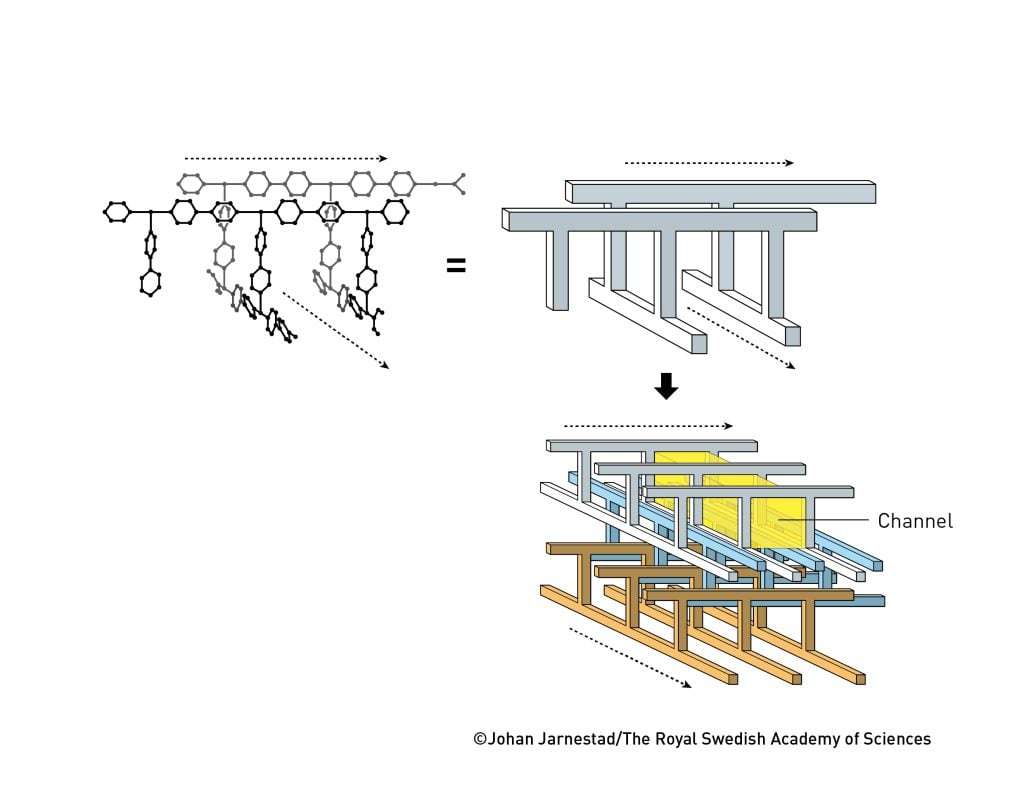
However,he did not give up and in1997he had his first major breakthrough.Using cobalt,nickel or zinc ions and a molecule called 4,4′-bipyridine,his research group created three-dimensional metal–organic frameworks that were intersected by open channels(figure3).When they dried one of these materials–emptying it of water–it was stable and the spaces could even be filled with gases.The material could absorb and release methane,nitrogen and oxygen,without changing shape.
Kitagawa sees the uniqueness of his creations
Kitagawa’s constructions were both stable and had a function,but research funders were still unable to see their charm.One reason was that chemists already had zeolites,stable and porous materials,which they could build from silicon dioxide.These can absorb gases,so why would anyone develop a similar material that did not work as well?
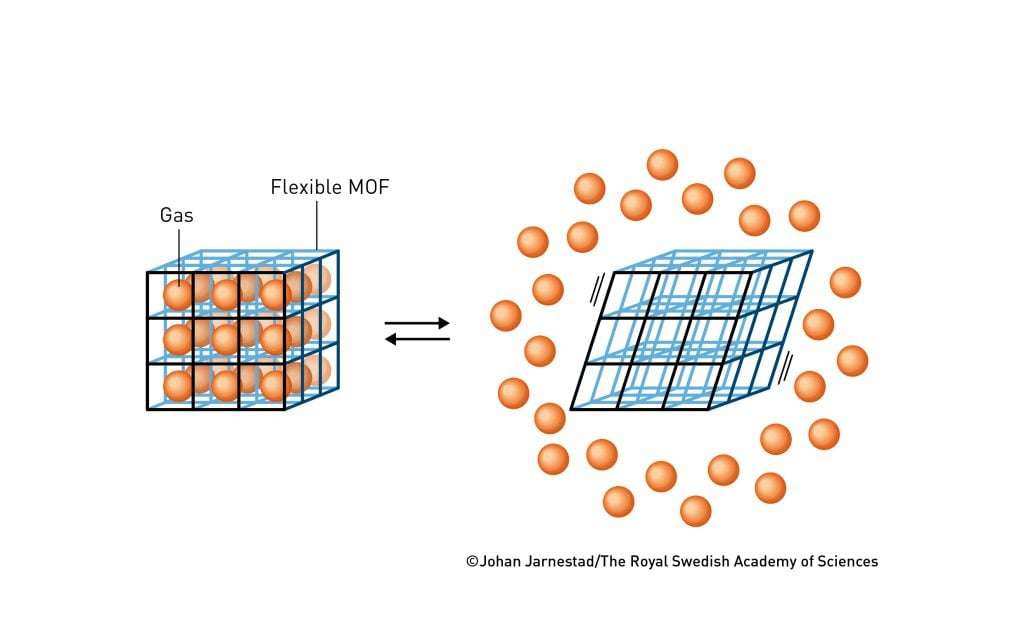
Susumu Kitagawa understood that if he were to receive any major grants,he had to define what made metal–organic frameworks unique.So,in1998,he described his vision in the Bulletin of the Chemical Society of Japan.He presented several advantages with MOFs.For example,they can be created from many types of molecules,so there is enormous potential for integrating different functions.Also–and this is important–he realised that MOFs can form soft materials.Unlike zeolites,which are usually hard materials,MOFs contain flexible molecular building blocks(figure4)that can create a pliant material.
After this,all he had to do was to put his ideas into practice.Kitagawa,along with other researchers,started developing flexible MOFs.While they work on this,we will move our focus to the US,where Omar Yaghi was also occupied with taking molecular architecture to new heights.
A secret library visit opens Yaghi’s eyes to chemistry
Studying chemistry was not an obvious choice for Omar Yaghi.He and his many siblings were raised in a single room in Amman,Jordan,with no electricity or running water.School was a refuge from his otherwise challenging life.One day,when he was ten years old,he sneaked into the school library,which was usually locked,and picked a book at random from the shelf.On opening it,his eyes were drawn to unintelligible but captivating pictures–his first encounter with molecular structures.
At the age of15–and on his father’s stern instruction–Yaghi moved to the US to study.He was attracted by chemistry and eventually by the art of designing new materials,but found the traditional way of building new molecules too unpredictable.Normally,chemists combine substances that are to react with each other in a container.Then,to start the chemical reaction,they heat the container.The desired molecule forms,but is also often accompanied by a range of contaminating side products.
In1992,when Yaghi started his first position as research group leader,at Arizona State University,he wanted to find more controlled ways in which to create materials.His aim was to use rational design to connect different chemical constituents,like pieces of Lego,to make large crystals.This turned out to be challenging,but they finally succeeded when the research group started combining metal ions with organic molecules.In1995,Yaghi published the structure of two different two-dimensional materials;these were like nets and were held together by copper or cobalt.The latter could host guest molecules in its spaces and,when these were fully occupied,it was so stable that it could be heated to350°C without collapsing.Yaghi describes this material in an article in Nature where he coins the name“metal–organic framework;”this term is now used to describe extended and ordered molecular structures that potentially contain cavities,and are built from metals and organic(carbon-based)molecules.
Just a few grams of Yaghi’s framework can contain a football pitch
Yaghi established the next milestone in the development of metal–organic frameworks in1999,when he presented MOF-5to the world.This material has become a classic in the field.It is an exceptionally spacious and stable molecular construction.Even when empty,it can be heated to300°C without collapsing.
However,what caused many researchers to raise their eyebrows was the enormous area hiding inside the material’s cubic spaces.A couple of grams of MOF-5holds an area as big as a football pitch,which means it can absorb much more gas than a zeolite could(figure5).
Speaking of the differences between zeolites and MOFs,it took just a few years for researchers to succeed in developing soft MOFs.One of those who was able to present a flexible material was Susumu Kitagawa himself.When his material was filled with water or methane,it changed shape,and when it was emptied,it returned to its original form.The material behaved somewhat like a lung that can breathe gas in and out,changeable but stable.
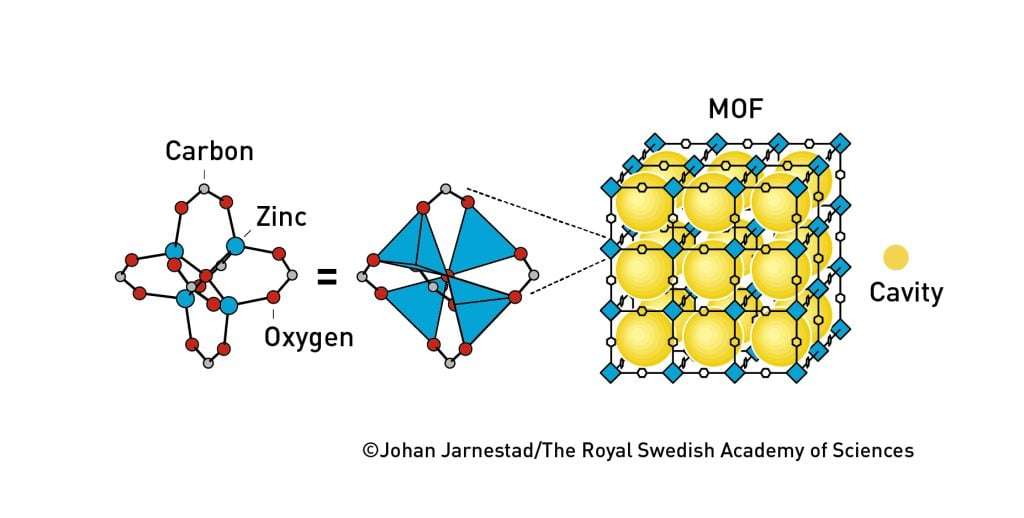
Yaghi’s research group conjures drinking water from desert air
Omar Yaghi laid the final bricks in the foundation of metal–organic frameworks in2002and2003.In two articles,in Scienceand Nature,he shows that it is possible to modify and change MOFs in a rational manner,giving them different properties.One thing he did was to produce16variants of MOF-5,with cavities that were both larger and smaller than those in the original material(figure6).One variant could store huge volumes of methane gas,which Yaghi suggested could be used in RNG-fuelled vehicles.
Subsequently,metal–organic frameworks have taken the world by storm.Researchers have developed a molecular kit with a wide range of different pieces that can be used to create new MOFs.These have different shapes and characters,providing incredible potential for the rational–or AI-based–design of MOFs for different purposes.Figure7provides examples of how MOFs can be utilised.For instance,Yaghi’s research group has harvested water from the desert air of Arizona.During the night,their MOF material captured water vapour from the air.When dawn came and the sun heated the material,they were able to collect the water.
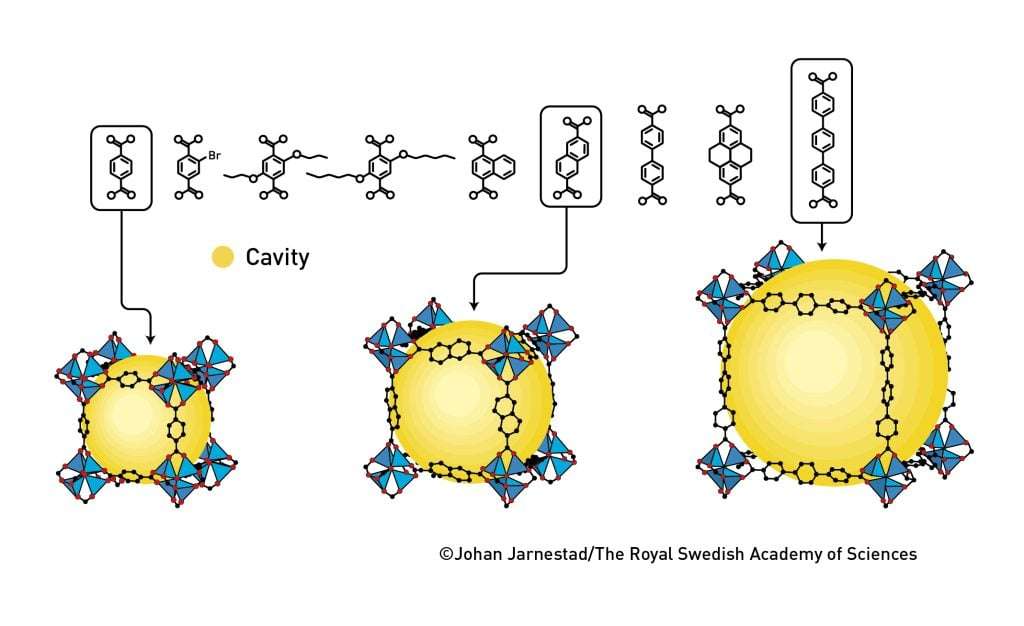
MOF materials that capture carbon dioxide and toxic gases
Researchers have created numerous different and functional MOFs.So far,in most cases,the materials have only been used on a small scale.To harness the benefits of MOF materials for humanity,many companies are now investing in their mass production and commercialisation.Some have succeeded.For example,the electronics industry can now use MOF materials to contain some of the toxic gases required to produce semiconductors.Another MOF can instead break down harmful gases,including some that can be used as chemical weapons.Numerous companies are also testing materials that can capture carbon dioxide from factories and power stations,to reduce greenhouse gas emissions.
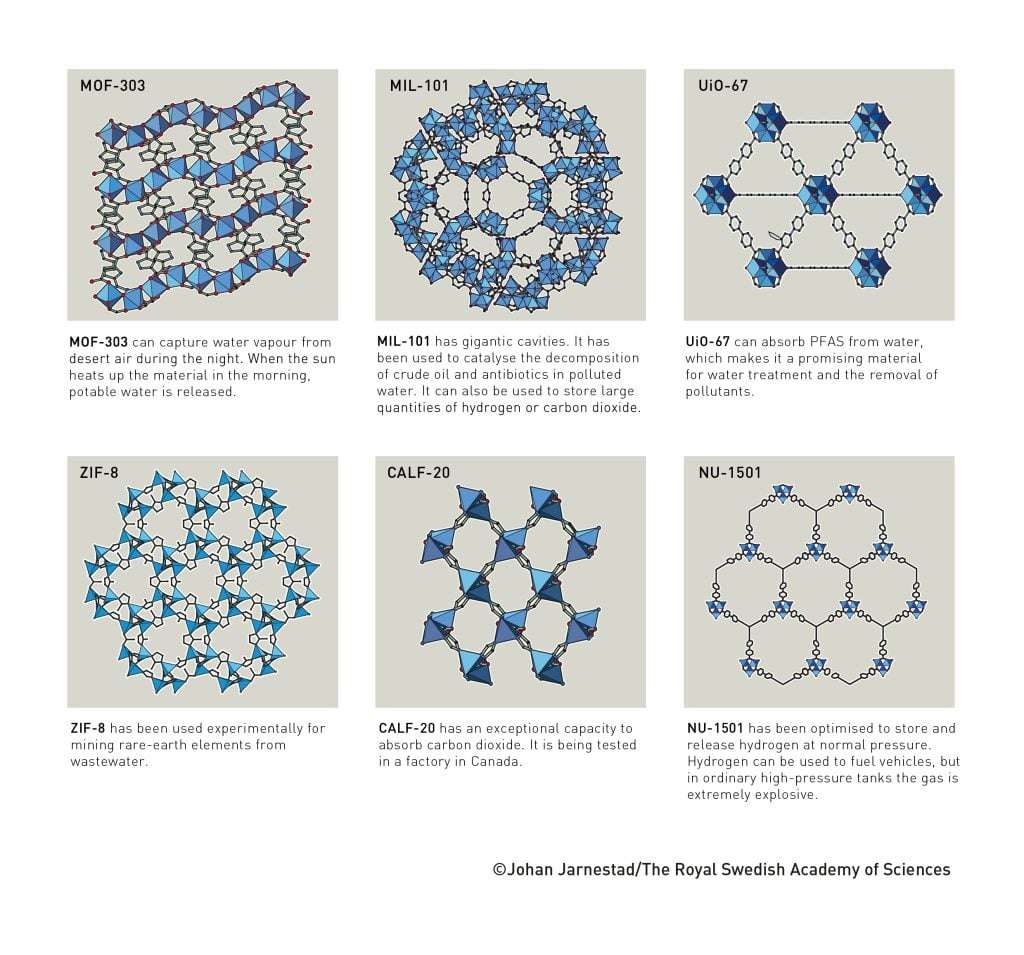
MOF-303can capture water vapour from desert air during the night.When the sun heats up the material in the morning,potable water is released.
MIL-101has gigantic cavities.It has been used to catalyse the decomposition of crude oil and antibiotics in polluted water.It can also be used to store large quantities of hydrogen or carbon dioxide.
UiO-67can absorb PFAS from water,which makes it a promising material for water treatment and the removal of pollutants.
ZIF-8has been used experimentally for mining rare-earth elements from wastewater.
CALF-20has an exceptional capacity to absorb carbon dioxide.It is being tested in a factory in Canada.
NU-1501has been optimised to store and release hydrogen at normal pressure.Hydrogen can be used to fuel vehicles,but in ordinary high-pressure tanks the gas is extremely explosive. ©Johan Jarnestad/The Royal Swedish Academy of Sciences
Some researchers believe that metal-organic frameworks have such huge potential that they will be the material of the twenty-first century.Time will tell,but through the development of metal-organic frameworks,Susumu Kitagawa,Richard Robson and Omar Yaghi have provided chemists with new opportunities for solving some of the challenges we face.They have thus–as Alfred Nobel’s will states–brought the greatest benefit to humankind.
Further reading
Additional information on this year’s prizes,including a scientific background in English,is available on the website of the Royal Swedish Academy of Sciences, www.kva.se,and at www.nobelprize.org,where you can watch video from the press conferences,the Nobel Prize lectures and more.Information on exhibitions and activities related to the Nobel Prizes and the prize in economic sciences is available at www.nobelprizemuseum.se.
The Royal Swedish Academy of Sciences has decided to award the Nobel Prize in Chemistry2025to
SUSUMU KITAGAWABorn1951in Kyoto,Japan.PhD1979from Kyoto University,Japan.Professor at Kyoto University,Japan.
RICHARD ROBSONBorn1937in Glusburn,UK.PhD1962from University of Oxford,UK.Professor at University of Melbourne,Australia.
OMAR M.YAGHIBorn1965in Amman,Jordan.PhD1990from University of Illinois Urbana-Champaign,USA.Professor at University of California,Berkeley,USA.
“for the development of metal-organic frameworks”
Science Editors:Peter Brzezinski,Heiner Linke,Olof Ramström and Xiaodong Zou,the Nobel Committee for Chemistry
Text:Ann Fernholm
Translation:Clare BarnesIllustrations:Johan Jarnestad
Editor:Alicia Hegner
©The Royal Swedish Academy of Sciences